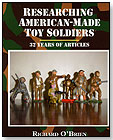
December 22, 2025

August 2011 | Vol. X - No. 8
Solving the Mystery of Composition Soldiers, Part I
Finding Playwood Plastics
 Tracking down the composition soldiers made in the United States during World War II had been next to impossible. Except for a "P" within a triangle on some of them, they bore no markings, no company name, no place of manufacture, and none of the many toy soldier employees I'd spoken to knew anything significant about them. It finally reached the point where it seemed that a lucky break was all that one could hope for.
Tracking down the composition soldiers made in the United States during World War II had been next to impossible. Except for a "P" within a triangle on some of them, they bore no markings, no company name, no place of manufacture, and none of the many toy soldier employees I'd spoken to knew anything significant about them. It finally reached the point where it seemed that a lucky break was all that one could hope for.
Then, at a Kennedy Toy Show, I got that break. While idly inspecting a few composition soldiers at a dealer's table, I was told by the dealer that if I were interested, he had a whole box. Something clicked, and I told him I'd be glad to see them. Sure enough, he had a box of them, all the same type -- the stocky pot-helmeted AA gunner, and on the side of the box were the words "Playwood Plastics Co. Inc., 200 Fifth Avenue, Factory in Brooklyn." At first, I didn't think the box was original (the dealer was not sure), as Plastics was the word I fixed on, but then when I realized the second word was Playwood, I began to think I was onto something.
Within a few days, I'd checked with the State of New York and found the company had been incorporated March 17, 1942, which seemed right as I recalled buying the composition sailor and Marine shortly after the start of World War II. I ordered the incorporation papers, found no owner names, but instead the title of the law firm handling the incorporation, and the names of four attorneys. As luck would have it, one of the latter was still in the Manhattan phone book, 37 years later. He didn't know much, but just enough to lead me onto the usual chain of informants, a chain that terminated with Michael Weiss, the most informed source I've encountered in my research at that time.
Weiss vividly recalled being approached in the spring or summer of 1943 by Reuben Roth, a former classmate in law school, and by Roth's client, a Mr. Smith. Smith's father had come up with a composition that could be molded into toy soldiers. They had a mold of an English soldier, but nothing else. Weiss was with Transogram, a company that had been in business since 1915, and they were looking for a new toy product. A subsidiary of theirs, Anchor Toy of Coudersport, Pennsylvania, had been making papier mache and wood accessories to go with nativity scenes (barns, wells, campfires, nativity cribs, etc.), but the nativity figures themselves had been imported. With the war on, and trading lines shut down, they were no longer available and the accessories had no value.
The year before, Transogram had incorporated a subsidiary company, Playwood Plastics, planning to use it for something else; now they decided this would be the name of the company making its soldiers. Weiss remembers frantically scrambling around, looking for scrap metal. This was wartime, with all metal being diverted to war purposes, but he finally found enough junk bronze to make the molds.
TO BE CONTINUED in the September issue of TDmonthly Magazine.
See:
"The Women Behind Toy Soldiers" by Richard O'Brien
Part I
Part II
Part III
Copyright © 2025 TDmonthly®, a division of TOYDIRECTORY.com®,
Inc.



 Tracking down the composition soldiers made in the United States during World War II had been next to impossible. Except for a "P" within a triangle on some of them, they bore no markings, no company name, no place of manufacture, and none of the many toy soldier employees I'd spoken to knew anything significant about them. It finally reached the point where it seemed that a lucky break was all that one could hope for.
Tracking down the composition soldiers made in the United States during World War II had been next to impossible. Except for a "P" within a triangle on some of them, they bore no markings, no company name, no place of manufacture, and none of the many toy soldier employees I'd spoken to knew anything significant about them. It finally reached the point where it seemed that a lucky break was all that one could hope for.